1950 Wheat Penny Coin Value: How Much Is It Worth?
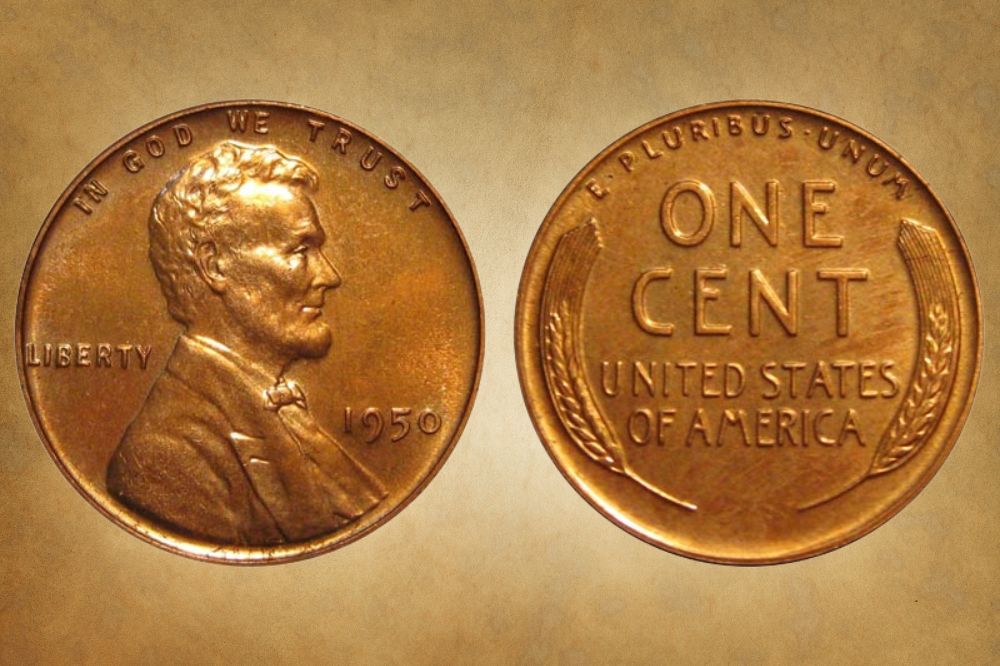
Have you ever seen a 1950 wheat penny? The value of this beautiful coin depends on its condition and rarity, but the 1950 wheat penny is a valuable one for collectors. Some are worth only a few cents, but others can be worth quite a bit more!
In this blog post, we will not only explore the history of the 1950 wheat penny, but we will also look at the coin’s features. After that, we will discuss its value in different conditions. We’ll even look at some of the error coins from 1950 that have sold for a lot of money!
So if you’re lucky enough to have one of these coins, make sure to read on. You won’t want to miss this information.
1950 Wheat Penny Value Chart |
||||
| Mint Mark | Good | Fine | Extremely Fine | Uncirculated |
| 1950 No Mark Wheat Penny | $0.01 | $0.05 | $0.35 | $0.96-$2.28 |
| 1950 D Wheat Penny | $0.01 | $0.05 | $0.22 | $0.67-$2.28 |
| 1950 S Wheat Penny | $0.01 | $0.05 | $0.08 | $0.96-$2.28 |
| 1950 Wheat Penny Proof | / | / | / | $79 |
Value of 1950 Wheat Penny
Now that we’ve gone over the 1950 wheat penny’s features, let’s finally answer our original question: What is the 1950 wheat penny value?
To answer this question, let’s look at the 1950 wheat penny by both condition and mint mark, because those are some of the main deciding factors.
When it comes to 1950 wheat pennies, “condition” refers to how well preserved the coin is – meaning its general appearance and state of wear. The better the condition, the higher its value will be. The different levels of the condition include Good, Fine, Extremely Fine, and Uncirculated.
1950 “No Mint Mark” Wheat Penny Value
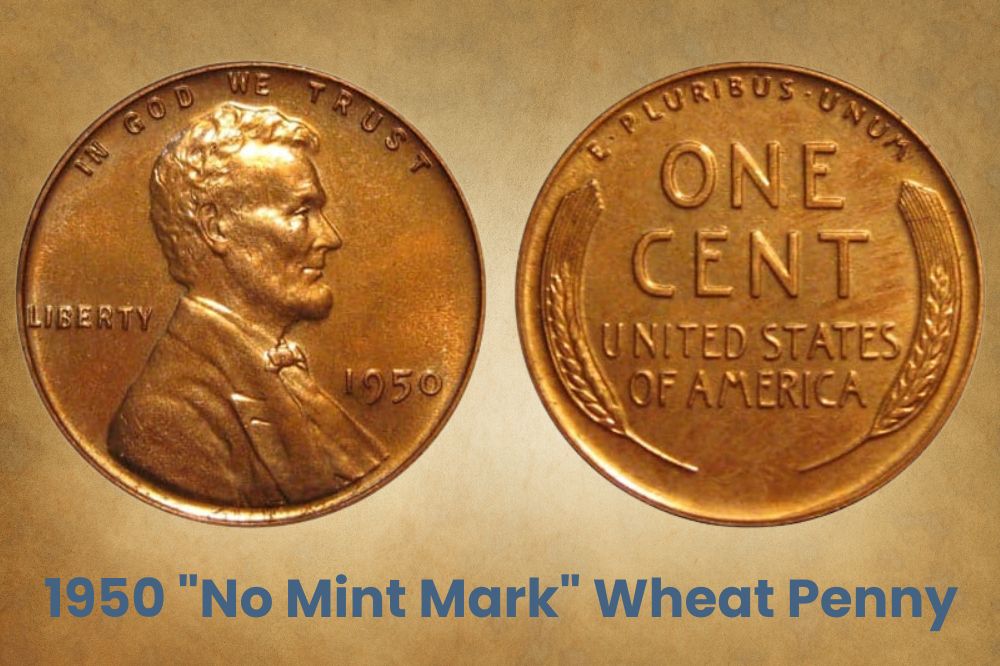
As we’ve mentioned, the 1950 wheat penny without a mint mark is from the US Mint location of Philadelphia. In that location, there were 272,635,000 wheat pennies minted in 1950.
The 1950 wheat penny values are typically a range of amounts. If you have a 1950 wheat penny that is in Good condition, it will likely be worth its face value (one cent). However, if you have a Fine condition coin, it could be worth five times that, at five cents.
These wheat pennies in Extremely Fine condition are usually worth about 35 cents, while the Uncirculated wheat pennies from 1950 are worth anywhere from about 96 cents to $2.28, depending on how perfect they are.
However, one almost-perfect condition penny from the Philadelphia mint recently sold at auction for $4,000, so you just never know!
1950 “D” Wheat Penny Value
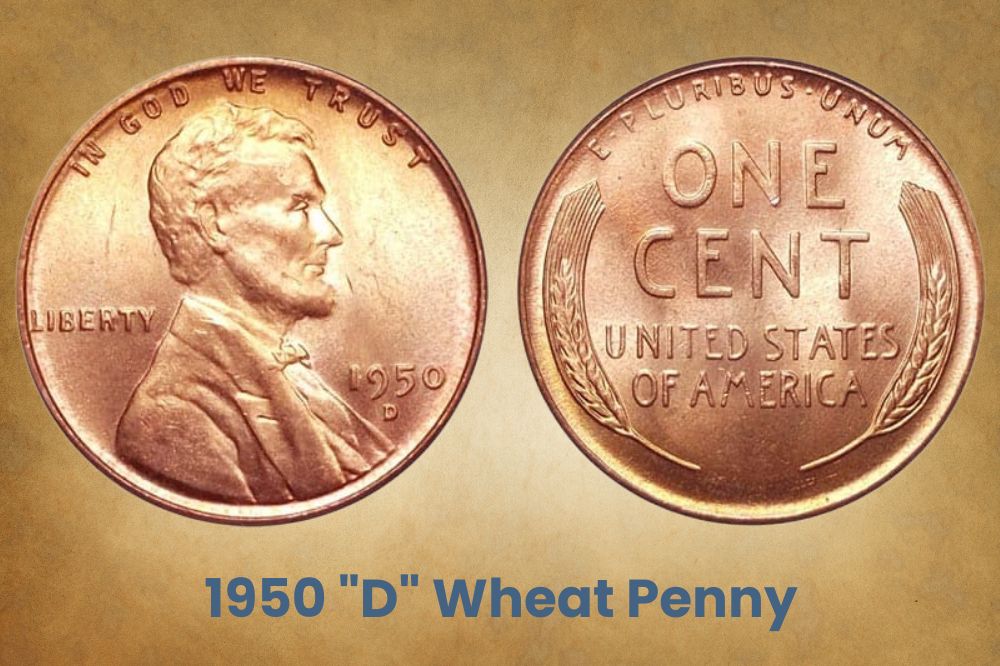
1950 wheat pennies with the “D” mint mark were produced by the US Mint’s location in Denver, Colorado. At that place, they minted 334,950,000 1950 pennies.
1950 “D” wheat penny values are similar to those of 1950 “No Mint Mark” values. In Good condition these coins are worth one cent, in Fine condition they are worth five cents, in Extremely Fine condition they are worth 22 cents, and Uncirculated 1950 “D” wheat pennies can be worth anywhere from 67 cents to $2.28 each.
So, overall, the baseline value of 1950 “D” wheat pennies is less than those from the Philadelphia mint, which is probably largely due to the number of coins minted. However, one with near-perfect condition can still bring in quite a lot of money at auction, such as one coin recently that went for about $15,000!
1950 “S” Wheat Penny Value
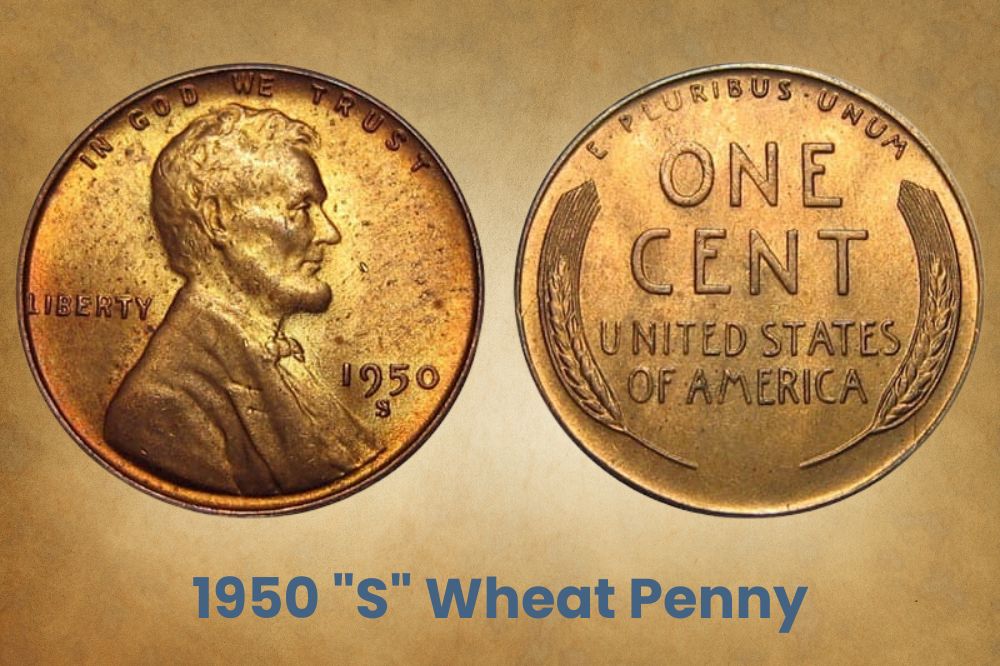
1950 wheat pennies with an “S” mint mark were produced by the US Mint’s location in San Francisco, California. There were 118,505,000 1950 “S” wheat pennies minted at that location, which makes it the smallest number of minted wheat pennies that year for business circulation.
The 1950 “S” wheat penny values are similar to those of 1950 “No Mint Mark” and 1950 “D” values but a little different. In Good condition these coins are worth one cent (face value), in Fine condition they are worth five cents, in Extremely Fine condition they are worth about eight cents, and in Uncirculated the 1950 “S” wheat pennies can be worth anywhere from 96 cents to $2.28 each.
However, it is possible that the 1950 “S” wheat pennies might hold a bit more value at auction than their counterparts due to the much lower number of coins produced compared to the Philadelphia and Denver. For example, a near-perfect Uncirculated grade 1950 penny went at auction recently for over $9,000! Wow!
1950 “Proof” Wheat Penny Value
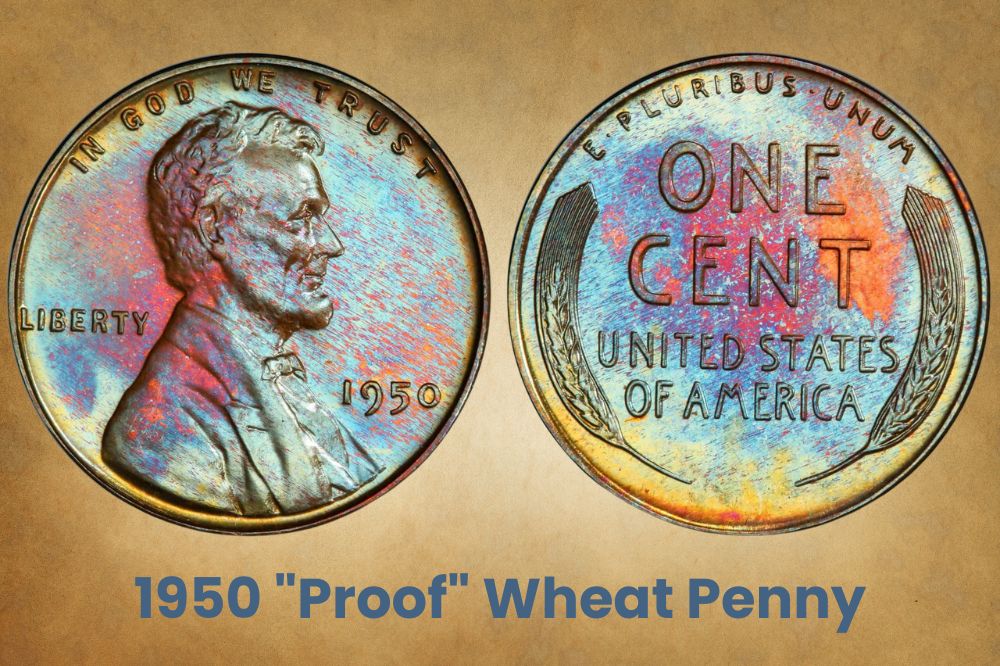
Finally, 1950 proof pennies are especially rare and valuable. They have a shiny finish like a mirror with higher detail than regular 1950 wheat pennies, and they can be worth a lot depending on the condition. They were created for collectors and not for business circulation.
During World War II, no proofs were made for any American coinage, but starting in 1950, proofs were minted once again, including that of the 1950 wheat penny. However, they only created a little over 51,000 of these coins, so they are very rare. Uncirculated, you will discover them to be worth around $79!
Related Posts: 16 Most Valuable Wheat Penny Errors
1950 Wheat Penny Error Coins
There are also 1950 wheat penny error coins, which can be worth much more than the standard 1950 wheat penny value. These 1950 pennies with errors could include a whole variety of errors, including but not limited to double dies, repunched mint marks, and other misprints that can make them quite valuable.
Let’s take a look at a few that sold for quite a lot at auctions:
1950 “D” Wheat Penny with Broadstruck Error
Credit: Greysheet
This 1950 “D” wheat penny was made by mistake with a broadstruck error, which means that it is missing some of the detail on the coin due to the way it was struck during the minting process. With this kind of mint error, this 1950 “D” wheat penny sold at auction for about $28.
Similarly, another 1950 wheat penny that was broadstruck (and double struck) went for about $95 at auction.
1950 “D” Wheat Penny with Off Center Strike Error
Credit: WorthPoint
This 1950 “D” wheat penny was made with a 20% off-center strike, which means that the coin wasn’t perfectly struck in the middle during the minting process. This error can make the image on the coin show up on only a portion of the planchet.
This particular 1950 “D” wheat penny sold at auction for over $180.
Another off center wheat penny from 1950 had a 60% error, and it sold at auction for about $225.
1950 “D” Wheat Penny Struck on a Ten Cent Planchet Error
Amazingly, one 1950 “D” wheat penny was made with an error where the penny was struck on a dime planchet. This can happen when different coins get mixed up during the minting process. This 1950 “D” wheat penny sold at auction for over $430 (and probably would have gone for more, except the owner cleaned it beforehand, which is not recommended).
1950 “S” Wheat Penny with Repunched Mint Mark Error
Finally, 1950 “S” wheat pennies with a repunched mint mark error can also be worth a lot of money. This error means that the mint mark was punched twice on the coin, resulting in one mark on top of another. A near-perfect 1950 “S” wheat penny recently sold at auction for over $115.
Related Posts: 19 Most Valuable Lincoln Memorial Penny Worth Money
History of 1950 Wheat Penny
The 1950 wheat penny is a coin from the United States of America that was produced in – you guessed it – 1950.
The 1950 wheat penny’s design dates back all the way to 1909, when the Lincoln cent began circulation as a commemoration to Abraham Lincoln’s 100th birthday. Abraham Lincoln was the United States’ 16th president and was memorialized because of his contribution to keeping the United States of America together during the American Civil War in the 1860s.
The designer of the coin was a Lithuanian immigrant named Victor David Brenner. He was commissioned to design the coin, and his initials (V.D.B.) can be seen on the bottom of the reverse of some of the wheat pennies and on the front of some other wheat pennies.
The 1950 wheat penny was produced just five years after World War II ended and in the same year that the Korean War began. It featured an image of Abraham Lincoln on its obverse side and two stalks of wheat on the reverse side, symbolizing strength and prosperity – something the United States really needed to feel in its morale during this time in history. The new design for the Lincoln cent would not be released until 1959.
All of the 1950 wheat penny coins were made out of copper alloy, but this was not always the case for wheat pennies throughout history. The composition changed during World War II to a thin layer of copper overtop steel because the United States needed to sacrifice its copper for the war effort. Once the War was over, the nation could go back to using copper in its coins.
So if you have a 1950 wheat penny or any other year’s wheat penny, it’s definitely worth holding on to it! It’s part of American history.
Related Posts: 19 Most Valuable Wheat Penny Worth Money
How to identify 1950 Wheat Penny?
The 1950 wheat penny has a few features that you should be aware of. Let’s look at the design on both the obverse and reverse side, the metal composition, the mint marks and their locations, and their size and weight.
The Obverse of the 1950 Wheat Penny
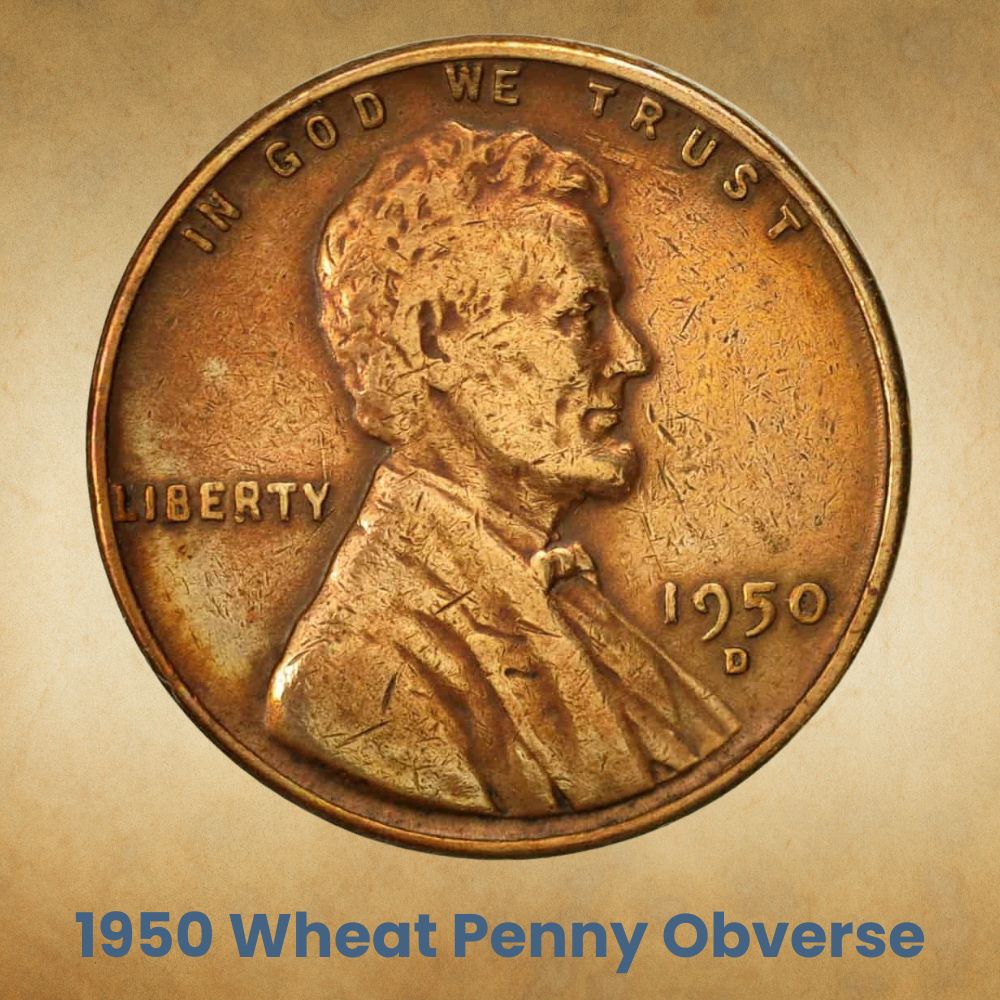
The 1950 wheat penny features a portrait of Abraham Lincoln on its obverse side. This design by Victor David Brenner was first used in 1909. It displays Lincoln’s stately profile facing left, with the words “IN GOD WE TRUST” arching above (center), the year 1950 on the far lower right, and the phrase “LIBERTY” between Lincoln’s ear and his shoulder in the space on the center left side of the coin.
This design is still used today for all US pennies, though it has been updated slightly.
The Reverse of 1950 Wheat Penny
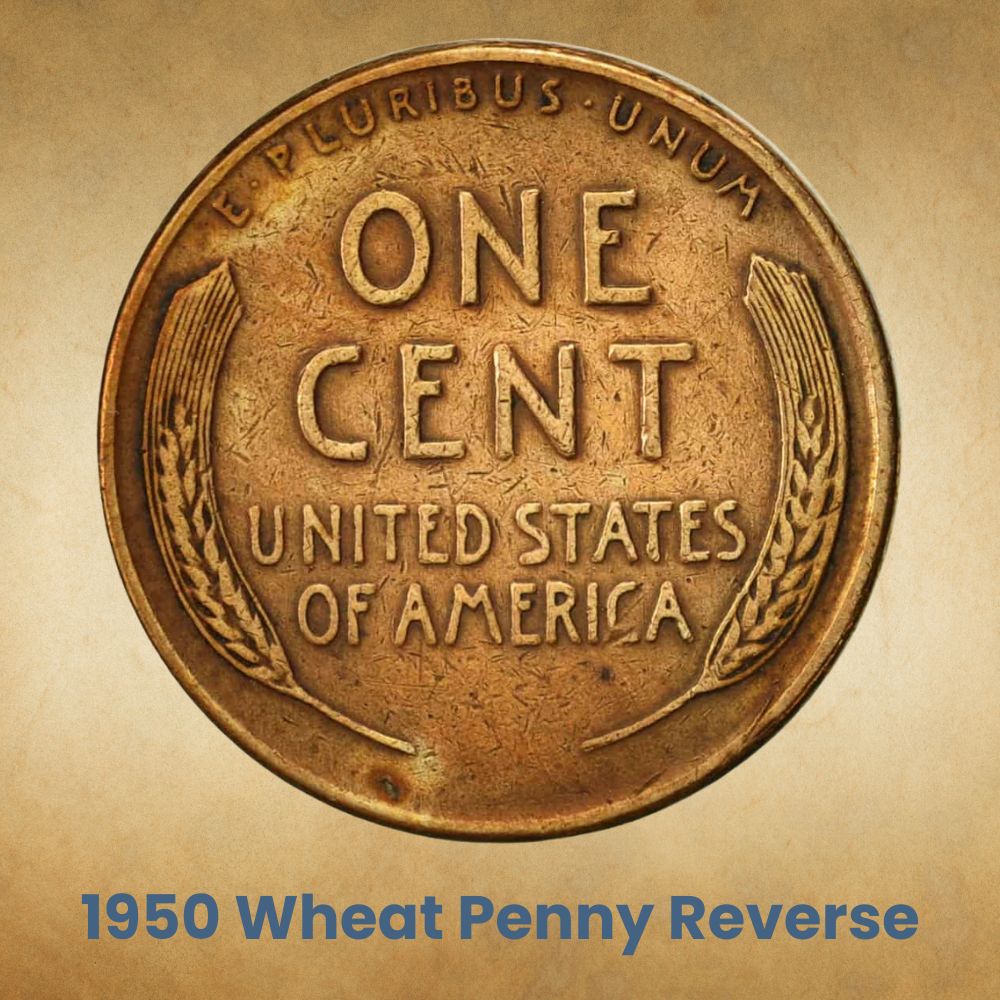
The reverse side of the 1950 wheat penny features two stalks of wheat edging the coin up both the left and the right side. At the top center, the words “ONE CENT” can be seen, showing the face value of the 1950 wheat penny. The phrase “UNITED STATES OF AMERICA” is written directly below that. In an arch above the wheat stalks reads “E PLURIBUS UNUM,” which is America’s motto, meaning “Out of Many, One.”
Other Features of the 1950 Wheat Penny
Now let’s take a look at the 1950 wheat penny’s other features.
Metal Composition
The 1950 wheat penny was made out of an alloy of 95% copper and 5% zinc, which is also known as a bronze composite. As we mentioned before, this was the same composition used for wheat pennies all the way back to 1909, with the exception of the wheat pennies made during World War II, which were changed to copper plated steel.
Mint Marks
The 1950 wheat penny was produced at several different mints across the United States: Philadelphia, Denver, and San Francisco. Those that were produced at the Philadelphia mint have no mint mark; however, 1950 wheat pennies produced at the Denver and San Francisco mints have a “D” and an “S” respectively.
The 1950 wheat penny mint marks can be found on the obverse side of the coin, just below the year “1950.”
Size and Weight
The 1950 wheat penny is 19.05 millimeters (0.75 inches) in diameter and weighs 3.11 grams.
Frequently Asked Questions
Now that you know a bit more about 1950 wheat penny value, here are some of the most frequently asked questions about 1950 wheat pennies, so you can get the answers you need in one place.
What Makes 1950 Wheat Pennies Valuable?
1950 wheat pennies can be valuable due to their condition, mint marks (or lack thereof), and errors.
Are 1950 Wheat Pennies Rare?
1950 wheat pennies can range from common to very rare depending on the type of coin you have – 1950 “S” wheat pennies are the rarest (of business circulation coins) due to their lower mintage numbers, while 1950 proof coins are especially rare.
Should I Clean my Coin Before Getting it Graded?
It is not recommended to clean any coins before grading, as this can actually lower the value and make it less desirable. It’s best to leave it as is and have it graded by a professional.
Conclusion
In conclusion, the 1950 wheat penny value can have a wide range of values, from face value all the way up to thousands of dollars. It really boils down to their condition, mint mark, and if there are any errors found on them.
No matter what 1950 wheat penny you have, though, it is worth researching its value before selling it away. It could be worth more than you think!
Do you have a 1950 wheat penny? Tell us about it in the comments below!

Got a 1950 Lincoln wheat penny
D mint how much it worth today
I have a 1950 no mint mark wheat penny, red brown, great condition.
I have a 1950 D wheat penny & I also have a 1950 wheat penny
I have a few 1950 wheat pennies from what I’m seeing all numbers in the date 1950 line up evenly from top of the date. But, I have a dated 1950 penny where the the 5 in the date is clearly above all other numbers . I would love to show you a picture. Email me if you’d like to see it.
My husband brought home a 1950 wheat penny. However the mint mark is double stamped and I think it’s an “s” but can’t tell for sure.
I found a 1950 D wheat penny , it is cut about half way thru the face.
I have an 1950s Penny wheat The coin is rare because you can see different sides apart from Lincoln
I have a 1950 wheat penny out of the Denver mint and I pretty sure have some errors but I could be wrong along the rim of the coin.
I have a 1950 D wheat penny that is double struck on the word trust